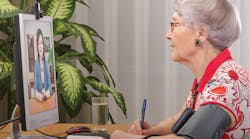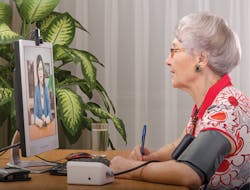Will teledental catch up? The pulse for dentistry's contribution often appears weak
By Audrey (AJ) Jarabek, RDH, RDA, CMT, BS, MAEd
As Francis Bacon can be quoted, "If we are to achieve results never before accomplished, we must employ methods never before attempted." As a veteran of dental hygiene for more than three decades, I remember being teased in my hygiene class as being the only student to wear the "recommended" latex gloves. After all, we didn't have to wear them. My thought was get used to them when everything already feels strange rather than adding the routine later.
Another concept from way-back-when was the idea of a dental hygienist being able to administer nitrous oxide sedation and local anesthesia. Really? To think of using a needle in someone's mouth without being a licensed dentist seemed absurd back in the early 1980s.
So it is amazing and exciting to be a dental hygienist in today's millennial world; everything is computerized, paperless, archived, and sent to anywhere in the world wirelessly.
My daughter works at the University of Minnesota in the National Center for Interprofessional Practice and Education. We have very interesting conversations about our chosen careers. Leaders in the United States and beyond see the need today for team-based, collaborative care models. This model begins with students and continues on into professional settings. The goal is commonly known as the "Triple Aim" concept, which focuses on ensuring the highest quality of care, at the lowest possible cost, and in all settings and professions. The changes underway within the health-care profession are happening at a faster pace than most can even grasp. With work, families, friends, social calendars, and sporting events how do we really keep up with it all?
As progressive dental hygienists, we are a population of health-care providers that directly serve patients' dental needs. But how is it that we really fit into the bigger picture of collaborative patient care at a global level?
Telemedicine meeting
Recently, I was invited to attend the American Telemedicine Association's annual meeting in Minneapolis. With over 4,200 registered participants, it was an awesome and overwhelming conference to attend. Classes offered to attendees included: "Retail kiosks in urgent care clinics: Why it's the new normal," "Managing telemedicine services within practice groups," and "Assimilation of virtual visits to the health-care system: Keeping quality at the forefront." Hundreds of exhibitors were obvious proof that the world is fast becoming a much more connected place, including all health-care disciplines.
The telemedicine entity incorporates every detail of a patient record within a medical cloud via computers, laptops, smart phones, or tablets. Information is readily transferred to anywhere in the world in regards to a patient's health history, current medical concerns and conditions, ambulance service, hospital, family, personal home-care service, attending physicians, pension, bank, etc.
While walking past a booth in the exhibit hall, I was asked if I would be using yesterday's technology for tomorrow's patient care? Hmm, the question got me to thinking. Telemedicine is everywhere. I quickly realized this when I was meeting high-ranking physicians, executives, and professional buyers from all around the world, including Venezuela, China, Sweden, and Switzerland.
As dental professionals, we need to respect that worldwide telemedicine is in full swing within our global borders. As interactive health-care professionals, we need to be aware of the changes that are upon us. As practicing clinical dental hygienists, we need to understand how we directly, and indirectly, play a part in this bigger, global, patient care picture.
It is widely recognized in telemedicine that all aspects of patient care are available through global interconnection. Many of these areas include telecardiology, telenursing, telepharmacy, teletrauma, telepsychiatry, teleradiolgoy, telepathology, teledermatology, teleaudiology, teleophthalmology, and, of course, teledentistry. The three most recognized methods of telecommunication seem to include: store and forward, remote monitoring, and real-time interactive measures. Through these avenues, doctors are able to record, review, and discuss directly with patients about their personal care needs.
For example, a clinician in Michigan can cite patient concerns, record notes, take digital diagnostic images, and have a live streaming consultation with a physician in Europe for more collaborative treatment and patient care. This is particularly useful in rural, remote areas where there may not be as many specializing physicians-and specializing dentists-available.
Two challenges
The many international physicians and executives expressed concerns about two areas. The first area is ophthalmology. An ophthalmologist from Venezuela said that it is rather difficult to use telemedicine techniques within the profession due to many diseases of the eye being internal, rather than external, making it difficult to consult with another physician or specialist. The second area is teledentistry.
Teledentistry is in the infant stages of development within the telemedicine circle. At the ATA annual meeting, only two companies contributed to the discipline of teledentistry.
One company was MouthWatch, an intraoral camera company based in New York City. Co-owners Brant Herman and Bob Bellhouse stated that their product is an intraoral camera at a "disruptively low cost with superior image quality." This is an amazingly lightweight and portable tool for dental hygienists, dentists, and all health-care personnel.
This intraoral camera would be great for working in settings such as public health programs, clinics, managed care settings, nursing home/assisted living facilities, school screening programs, employers, hospitals, and traditional dental practices, depending on scope of practice within a state. Through this intraoral imaging device, registered dental hygienists, along with all health-care providers, are able to go out into the field to do screening examinations, take intraoral images, and then store-and-forward those images along with all of the collected data to a supervising dentist for a consult.
Another option with this camera is that it has its own TeleDent software program available. This software is able to upload and store tons of additional patient information, including such things as health history forms, parent/patient consent forms, and pertinent patient information and comments. Through the camera and available software program, it enables clinicians and supervising dentists/physicians to have a live stream consultation-between, for example, a school parent, a dental hygienist, and a clinical dentist. Or, the consultation could be conducted between a nursing home attendant, a dental hygienist, a patient family member, and a supervising dentist, all in the comfort of their own homes and comfortable surroundings at a time that fits into everyone's busy schedules. It should be noted here that this software system can even upload and incorporate digital diagnostic radiographic images to be included for use during the consultation. Of course, a portable x-ray unit would be required.
The only other dental exhibitor representation during the ATA meeting was The Dentist Is In. Dr. Maria Kunstadter of Kansas City, Mo., stated, "This is a kiosk-based dental consultation and referral system which will provide a virtual dentist where one has always been needed. Our system allows emergency departments, urgent care centers, and retail-based clinics to have a dentist available 24/7/365 from our online professionals. For a growing number of Americans, the emergency room is the first line of treatment for dental care."
Dr. Kunstadter added, "According to the American Dental Association, between $1.7 to $2.2 billion dollars was spent in the ER in one year for dental complaints. That's because emergency rooms are not generally staffed by a dentist. It's the wrong service in the wrong place at the wrong time."
Another company at the ATA conference that is easily recognized by dental hygienists was Philips. The makers of the Sonicare toothbrush has recently launched a few new products, including a bath scale, pulse rate monitor, and blood pressure cuff. All of these are able to contribute to the global telemedicine sector of care. From the comfort of a patient's home, a remote health-care provider can closely monitor such things as patient weight, pulse, and blood pressure on a daily basis. Watching for elevations, declines, or any changes of these vital signs could alert an attending physician that the patient may need to be seen again or readmitted into a hospital setting.
Another telemedicine contributor that I found to be clinically interesting was thera-LINK. Carol Park along with co-founder Heather Potter stated that "thera-LINK is a secure video company that offers a user-friendly platform with affordable prices focused on the mental health industry." While talking with them, I learned that an individual patient, couple, or family can have a private counseling video session from the comfort of their own home. But another way this easy-to-use platform can be used is by the online coordination of care with colleagues, and it is made affordable for everyone involved.
So how does all of this connect with our daily roles and clinical dental hygienists? As practicing dental clinicians, it is imperative that we stay updated with all upcoming and evolving practices within the dental profession. It is of utmost importance that we practice accurate charting measures and make extensively detailed chart notes. If we as a profession are to remain competitive within the world of telemedicine, we must act now in educating ourselves in all aspects of the new global way of interactively practicing teledentistry and telemedicine. RDH
Audrey (AJ) Jarabek, RDH, RDA, CMT, BS, MAEd, is a clinical representative and key opinon leader for Young Dental Innovations. She practices part time as a clinical hygienist with her passion being a Forensic Dental Hygienist active with DMORT, MiMort/DART, and OMORT federal and state disaster mortuary response teams. AJ is an educator, published writer, CE speaker, and massage therapist trained in TMJ massage and myofascial release to the skull. She is a 2011 Sunstar/RDH Award of Distinction recipient. AJ can be contacted at [email protected].







